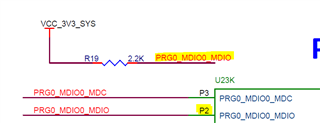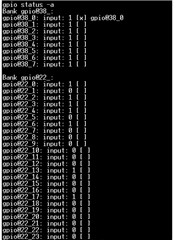Part Number: TMDS64GPEVM
Hello,
I am trying to configure some GPIOS of my EVM as inputs and outputs, whose state could be changed at runtime, therefore I think gpio-hog is not a solution because as far as I understand it prevents the gpio to be changed by the user space.However I have tried with and without the gpio-hog property but all the gpios are always set as inputs. I've also considered changing pullup-pulldown settings but it doesn't seem to change anything. So my question is, is it normal that by default the pins are all inpts ? If not, how could I set the direction from the device tree ? Thank you
Here is my setup :
&main_pmx0 {
gpios_test_pins_default: gpios-test-pins-default {
pinctrl-single,pins = <
AM64X_IOPAD(0x0168, PIN_INPUT, 7) /* (U2) PRG0_PRU0_GPO2.GPIO1_2 */
AM64X_IOPAD(0x016c, PIN_OUTPUT_PULLDOWN, 7) /* (V2) PRG0_PRU0_GPO3.GPIO1_3 */
AM64X_IOPAD(0x0180, PIN_INPUT, 7) /* (T2) PRG0_PRU0_GPO8.GPIO1_8 */
AM64X_IOPAD(0x01b4, PIN_OUTPUT, 7) /* (W2) PRG0_PRU1_GPO1.GPIO1_21 */
AM64X_IOPAD(0x0200, PIN_OUTPUT, 7) /* (P2) PRG0_MDIO0_MDIO.GPIO1_40 */
AM64X_IOPAD(0x0204, PIN_INPUT, 7) /* (P3) PRG0_MDIO0_MDC.GPIO1_41 */
>;
};
};
&main_gpio1 {
pinctrl-names = "default";
pinctrl-0 = <&gpios_test_pins_default>;
status = "okay";
gpio-line-names = "", "", "INT", "RESET", "", "", "", "",
"TEST1", "", "", "", "", "", "", "", "", "", "", "", "",
"WAKEUP", "", "", "", "", "", "", "", "", "", "", "", "", "", "", "", "", "", "", "TEST2", "TEST3";
gpio_int {
gpios = <2 0>;
input;
};
gpio_reset {
gpios = <3 0>;
output-low;
};
gpio_wakeup {
gpio-hog;
gpios = <21 0>;
output-high;
};
};




 .
.